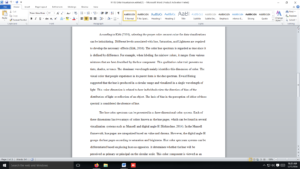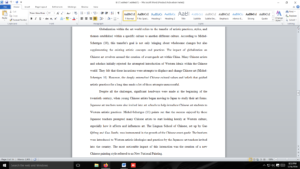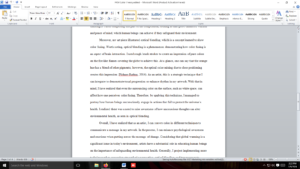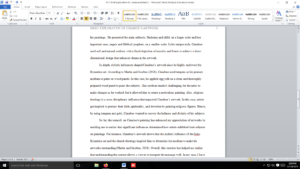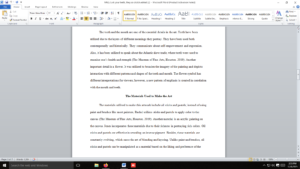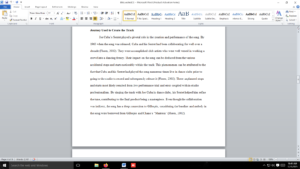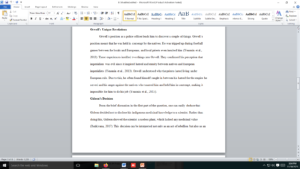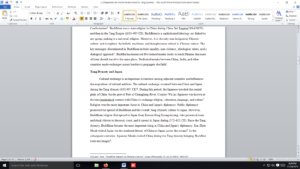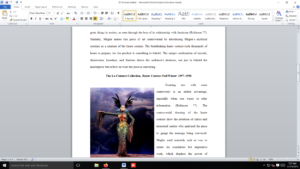Health & Medical Question
Choose one work that particularly engages you. Take time to look at the work in detail; include a picture of the work. Ask yourself: “How does the piece ‘work’? What is the artist doing? Why do I have a particular response (such as joy, fear, curiosity)?” Your response is, to a great extent, the result of the choices the artist has made in the process of creation. You will find useful ideas for thinking and writing about works of art in the text which was required for this course in chapter 1. The following is a specific outline for this paper. Part of your grade will be determined by how well you follow this outline. Other important aspects are thoroughness, clarity, and a demonstrated sensitivity to the work of art as shown in the rubric at the end. Parts 3 and 6 are 80% of the grade for this paper.
YOU ARE NOT ALLOWED TO DO THIS ON THE FOLLOWING WORKS OF ART – THEY WILL NOT BE ACCEPTED
MONA LISA BY DA VINCI LAST SUPPER BY DA VINCI
ANYTHING IN THE SISTINE CHAPEL (INCLUDING THE CREATION OF ADAM) BY MICHELANGELO
THE SCREAM BY EDVARD MUNCH STARRY NIGHT BY VAN GOGH STATUE OF LIBERTY
EIFFEL TOWER
THE SCREAM – MUNCH DAVID BY MICHELANGELO
PIETA – MICHELANGELO
LAD MENINAS – DIEGO VELAZQUEZ
THE KISS – GUSTAVE KLIMT
Write the paper numerically (#1,2,3,4,6,7)
1. State the title, artist, date, dimensions, and medium (what it is made of) of the work.
2. State the name of the exhibition in which the work was displayed.
3. Introduce the reader to the work of art by writing a brief, overall description of it. (Simple
not detailed)
4. Discuss the Elements of Art and Principles of Design that you think are important in understanding and analyzing this work.
5. Always refer to the artist by her or his last name, not the first name.
6. Explain your personal response to the work based on its form as you analyzed it in the previous sections. (Why did you like/dislike it?)
7. Include a photograph/picture of the artwork (Google images or similar)
The following list of the Elements of Art and the Principles of Design will help you to focus on the most important aspects of the work you are analyzing. Discuss the element or principles that seem to create the meaning of the work or contribute to its aesthetic quality.
1. Elements of Art
o line – shape and mass – light, value, color – texture – space – time and motion
1
2. Principles of Design
o unity and variety – balance – emphasis – focal point – proportion and scale – rhythm
Although different texts may sometimes use different terms, the basic concepts are the same. The textbook reviews some fundamental terms in the “Introduction” to your textbook for this course. If you should want an additional review of these elements and principles, consult any textbook for a college level Art Appreciation or Art History course.
Keep in mind:
1. Writing a formal analysis does involve your interpretation of and personal response to the work, but your reactions must be supported by referring to specific elements and qualities which you see in the work.
2. Accept the work as it is. Do not “second guess” the artist and make such statements as, “I think the painting would have been better if the artist had . . .”
3. Titles of exhibitions are in quotation marks; titles of works of art are underlined or are in italics.
Common mistakes you will want to avoid:
1. Failure to proofread your paper to check for spelling, punctuation, subject/verb agreement, incomplete sentences, run-on sentences, etc. Don’t rely on your computer’s spellchecker; the computer may not know if you mean “there” or “their.”
2. Confusing “it’s” and “its.”
3. Referring to the artist by her/his first name. Would you write English literature paper on Romeo
and Juliette and refer to the author as “William”?
4. Handing in your paper and asking me if I have a stapler.
2
Rubric
Demonstrates Emerging College-Level Writing
1
Demonstrates Satisfactory College-Level Writing
2
Demonstrates Proficient College-Level Writing
3
Demonstrates Exemplary College-Level Writing
4
Demonstrates Effective Development: Thesis Statement, Main
points, Supporting information
Thesis evident but support very general and/or inconsistent.
Several factual errors
Thesis evident but supported by a mixture of generalizations and specific detail.
Some factual errors
Thesis, stated or implied, presents a plan of development that is carried out.
Effective supporting details.
Consistent development.
No factual errors.
Stated or implied thesis developed logically, coherently and extensively with convincing, specific supporting details.
Strong evidence of critical thinking.
No factual errors.
Rubric
Demonstrates Emerging College-Level Writing
1
Demonstrates Satisfactory College-Level Writing
2
Demonstrates Proficient College-Level Writing
3
Demonstrates Exemplary College-Level Writing
4
Demonstrates Effective Organization of Content
Loose focus on central idea, contains some repetition and digression.
Paragraph structure weak.
Central idea evident.
Paragraph structure sometimes supports content.
Consistency, logic and transitions show some weaknesses.
Central idea clear.
Paragraph structure uniformly supports content.
Consistenc y, logic and transitions well managed
Central idea clear.
Paragraph structure consistently and effectively supports content.
Clear logic and effective transitions
3
Rubric
Demonstrates Emerging College-Level Writing
1
Demonstrates Satisfactory College-Level Writing
2
Demonstrates Proficient College-Level Writing
3
Demonstrates Exemplary College-Level Writing
4
Employs Effective Language
Frequent errors in word choice.
Sentence structure and mechanics seriously affect clarity.
Word choice correct but simple/ without variety.
Errors in mechanics and/ or usage do not obscure content of assignment.
Word choice accurate, varied.
Occasional errors in sentence structure, usage and mechanics do not hinder writer’s ability to communicate purpose.
Choice of language consistently precise, purposeful.
Nearly flawless sentence structure, usage, mechanics contribute to writer’s ability to communicate purpose.
Rubric
Demonstrates Emerging College-Level Writing
1
Demonstrates Satisfactory College-Level Writing
2
Demonstrates Proficient College-Level Writing
3
Demonstrates Exemplary College-Level Writing
4
Addresses Purpose and Audience
Wavers in purpose, incompletely addresses assigned topic or directions, shows need for more study of issues.
Style uneven.
Adheres to purpose, fulfills assignment, shows adequate understanding of key issues.
Style generally appropriate to intended audience.
Communicates purpose clearly.
Shows full understanding of issues.
Style consistently effective for intended audience.
Communicates purpose with sophistication.
Beyo nd understanding of issues, shows insight.
Style engages audience, establishes writer’s credibility.
4
Requirements: 2-3 pages | .doc file
Answer preview
- . The linen of the headgear does not seem exquisite, and it looks like a material that was designed to identify someone by their profession. Part of the headgear material also marches that of her coat, which gives more weight to the assumption that she was wearing a uniform. I also believe that the background of the painting indicates that the lady did not have a superior position in society. The background is dark, suggesting that it might not have been taken in an exclusive setting as most people in power or money did in the past.
- However, what is confusing, in this case, is the earring that the lady wore. In the painting, the earing appears like it is made out of silver, which was a preserve of the rich and the ruling class in the old society. However, there is also a possibility that the earring she had on might not be original. I also think that given the pleasant nature that the artist captures, the lady might have had a good relationship with the artist, and this being the case, the artist might have given her the earring. What interests me the most in this painting is the way the lady stares at the painter. It indicates as if she had a strong bond with him, which would be strange because she was just a house help.
[674 Words]
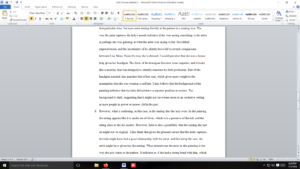
College level Art Appreciation
